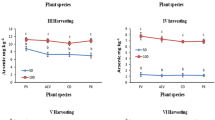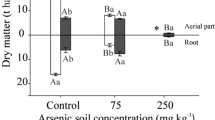Abstract
In the ChiuChiu village (Atacama Desert, Chile), there is a high concentration of arsenic (As) in the soil due to natural causes related to the presence of volcanoes and geothermal activity. To compare the levels of As and the growth parameters among plants of the same genus, three species of plants were established in situ: Atriplex atacamensis (native of Chile), Atriplex halimus, and Atriplex nummularia. These soils have an As concentration of 131.2 ± 10.4 mg kg−1, a pH of 8.6 ± 0.1, and an electrical conductivity of 7.06 ± 2.37 dS m−1. Cuttings of Atriplex were transplanted and maintained for 5 months with periodic irrigation and without the addition of fertilizers. The sequential extraction of As indicated that the metalloid in these soils has a high bioavailability (38 %), which is attributed to the alkaline pH, low organic matter and Fe oxide content, and sandy texture. At day 90 of the assay, the As concentrations in the leaves of A. halimus (4.53 ± 1.14 mg kg−1) and A. nummularia (3.85 ± 0.64 mg kg−1) were significantly higher than that in A. atacamensis (2.46 ± 1.82 mg kg−1). However, the three species accumulated higher levels of As in their roots, indicating a phytostabilization capacity. At the end of the assay, A. halimus and A. nummularia generated 30 % more biomass than A. atacamensis without significant differences in the As levels in the leaves. Despite the difficult conditions in these soils, the establishment of plants of the genus Atriplex is a recommended strategy to generate a vegetative cover that prevents the metalloid from spreading in this arid area through the soil or by wind.




Similar content being viewed by others
References
Abu-Zanata, M. W., et al. (2004). Increasing range production from fodder shrubs in low rainfall areas. Journal of Arid Environments, 59, 205–216.
Adriano, D. C. (2001). Trace elements in terrestrial environments (2nd ed.). New York: Springer. 867 p.
Akhani, H., et al. (1997). Photosynthetic pathways in Chenopodiaceae from Africa, Asia and Europe with their ecological, phytogeographical and taxonomical importance. Plant Systematics and Evolution, 206, 187–221.
Ali, H., et al. (2013). Phytoremediation of heavy metals—concepts and applications. Chemosphere, 91, 869–881.
Alloway, B. (2010). Heavy metals in soil. Trace metals and metalloids in soil and their bioavailability. New York: Springer. 613 p.
Arshad, M., et al. (2008). A field study of lead phytoextraction by various scented Pelargonium cultivars. Chemosphere, 71, 2187–2192.
Ascar, L., et al. (2008). Effect of biosolid incorporation on arsenic distribution in Mollisol soils in central Chile. Chemosphere, 70, 1211–1217.
Belkheiri, O., & Mulas, M. (2013). The effects of salt stress on growth, water relations and ion accumulation in two halophyte Atriplex species. Environmental and Experimental Botany, 86, 17–28.
Brady, N. C., & Weil, R. (2002). The nature and properties of soils (13th ed.). New Jersey: Prentice Hall. 975 p.
Bundschuh, J., et al. (2012). Arsenic in the human food chain: the Latin American perspective. Science of the Total Environment, 429, 92–106.
Cáceres, L., et al. (1992). Water recycling in arid regions. Chilean case. Ambio, 21, 138–144.
Clemente, R., et al. (2012). The use of a halophytic plant species and organic amendments for the remediation of a trace elements-contaminated soil under semi-arid conditions. Journal of Hazardous Materials, 223–224, 63–71.
Díaz, O., et al. (2011). Total and bioavailable arsenic concentration in arid soils and its uptake by native plants from the Pre-Andean zones in Chile. Bulletin of Environmental Contamination and Toxicology, 666–669.
Figueroa, J., et al. (2004). Exotic plant invasion to the Mediterranean region of Chile: causes, history and impacts. Revista Chilena de Historia Natural, 77, 465–483.
Fitz, W. J., & Wenzel, W. (2002). Arsenic transformations in the soil–rhizosphere–plant system: fundamentals and potential application to phytoremediation. Journal of Biotechnology, 9, 259–78.
Ghosh, M., & Singh, S. P. (2005). A comparative study of cadmium phytoextraction by accumulator and weed species. Environmental Pollution, 133, 365–371.
Gomes, I., et al. (2008). Fitorremediaçăo de solo salino sódico por Atriplex nummularia e gesso de Jazida. Revista Brasileira de Ciência do Solo, 32, 1065–1072.
Hernández-Allica, J., et al. (2008). Assessment of the phytoextraction potential of high biomass crop plants. Environmental Pollution, 152, 32–40.
Kabata-Pendias, A. (2011). Trace elements in soil and plants. 4th Edition (520 p). CRC Press NY.
Komárek, M., et al. (2013). Chemical stabilization of metals and arsenic in contaminated soils using oxides. A review. Environmental Pollution, 172, 9–22.
Lailhacar, S., & Torres, C. (2001). Influencia de los arbustos del género Atriplex L. con y sin corte de rebaje en el comportamiento del estrato herbáceo del secano arido. 1. Efecto del arbusto promedio del género sobre las características cuantitativas del estrato herbáceo total. Avances Producción Animal, 26, 79–96.
Lailhacar, S., et al. (1991). Soil variables to be considered when selecting soils for plantation of the shrub Atriplex nummularia Lindl. Avances Producción Animal, 16, 47–66.
Lailhacar, S., et al. (1995). Rendimiento de leña y recuperación al corte en diferentes especies y procedencias arbustivas del género Atriplex. Revista de Ciencias Forestales, 10(1–2), 85–97.
Latorre, C., et al. (2006). Late quaternary vegetation and climate history of a perennial river canyon in the Río Salado basin (22°S) of northern Chile. Quaternary Research, 65, 450–466.
Le Houérou, H. N. (1992). The role of saltbushes (Atriplex spp.) in arid land rehabilitation in the Mediterranean basin: a review. Agroforestry Systems, 18, 107–148.
Litter, M., et al. (2010). Possible treatments for arsenic removal in Latin American waters for human consumption. Environmental Pollution, 158, 1105–1118.
Luebert, F., & Pliscoff, P. (2006). Sinposis bioclimática y vegetacional de Chile (316 p.) Universitaria, Chile.
Lutts, S., et al. (2004). Heavy metal accumulation by halophyte species Mediterranean saltbush. Journal of Environmental Quality, 33, 1271–1279.
Madejon, P., et al. (2002). Bioaccumulation of As, Cd, Cu, Fe and Pb in wild grasses affected by the Aznalcollar mine spill (SW Spain). Science of the Total Environment, 290, 105–120.
Madejón, P., & Lepp N. W. (2007). Arsenic in soils and plants of woodland regenerated on an arsenic-contaminated substrate: a sustainable natural remediation? Science of Total Environmental, 379, 256–262.
Manousaki, E., & Kalogerakis, N. (2009). Phytoextraction of Pb and Cd by the Mediterranean saltbush (Atriplex halimus L.): metal uptake in relation to salinity. Environmental Science and Pollution Research, 16, 844–854.
Manousaki, E., & Kalogerakis, N. (2011). Halophytes—an emerging trend in phytoremediation. International Journal of Phytoremediation, 13, 959–969.
McGrath, S. P., & Zhao, F. J. (2003). Phytoextraction of metals and metalloids from contaminated soils. Current Opinion in Biotechnology, 14, 277–282.
Mendez, M., et al. (2007). Phytostabilization potential of quailbush for mine tailings: growth, metal accumulation, and microbial community changes. Journal of Environmental Quality, 36, 245–253.
Moreno-Jiménez, E., et al. (2010). Hydroponics as valid tool to assess arsenic availability in mine soils. Chemosphere, 79, 513–7.
Moreno-Jiménez, E., et al. (2012). The fate of arsenic in the soil-plant system. Reviews Environmental Contamination and Toxicology, 215, 1–37.
Muñoz, O., et al. (2002). Vegetables collected in the cultivated Andea Area of Northern Chile: total and inorganic arsenic contents in raw vegetables. Journal of Agricultural and Food Chemistry, 50, 642–647.
Nedjimi, B. (2014). Effects of salinity on growth, membrane permeability and root hydraulic conductivity in three saltbush species. Biochemical Systematics and Ecology, 52, 4–13.
Pérez-Esteban, J., et al. (2013). Bioavailability and extraction of heavy metals from contaminated soil by Atriplex halimus. Environmental and Experimental Botany, 88, 53–59.
Pizarro, I., et al. (2003). Distribution of arsenic species in environmental samples collected in Northern Chile. International Journal of Environmental Analytical Chemistry, 83, 879–890.
Poblete, V., et al. (1991). Anatomical leaf adaptations in vascular plants of salt marsh in the Atacama Desert (Chile). Revista Chilena de Historia Natural, 64, 65–75.
Queirolo, F., et al. (2000). Total arsenic, lead, and cadmium levels in vegetables cultivated at the Andean villages of northern Chile. Science of theTotal Environment, 255, 75–84.
Riedemann, P., et al. (2006). Flora nativa de valor ornamental. Identificación y propagación. Chile zona Norte (404 p). Riedemann, Aldunate, Teillier. Chile.
Romero, L., et al. (2003). Arsenic enrichment in waters and sediments of the Rio Loa (Second Region, Chile). Applied Geochemistry, 18, 1399–416.
RSA (1997). Reglamento Sanitario de los Alimentos, Chile. D. Oficial de la República de Chile 35764, 3–32.
Saiz, F., et al. (2000). Biodiversidad de complejo de artrópodos asociados al follaje de la vegetación del norte de Chile, II Región. Revista Chilena de Historia Natural, 73, 671–692.
Sánchez, A., & Morales, R. (2004). Las Regiones de Chile. Cuarta edición (152 p). Universitaria. Chile.
Santibáñez, C., et al. (2008). Phytostabilization of copper mine tailings with biosolids: implications for metal uptake and productivity of Lolium perenne. Science of the Total Environment, 395, 1–10.
Tapia, Y., et al. (2011). Phytoextraction of cadmium by four Mediterranean shrubs species. International Journal of Phytoremediation, 13, 567–579.
Tapia, Y., et al. (2013a). Atriplex atacamensis and Atriplex halimus resist as contamination in Pre-Andean soils (northern Chile). Science of the Total Environmental, 450–451, 188–196.
Tapia, Y., et al. (2013b). Effect of citric acid on metals mobility in pruning wastes and biosolids compost and metals uptake in Atriplex halimus and Rosmarinus officinalis. Environmental Monitoring and Assessment, 185, 4221–4229.
Visoottiviseth, P., et al. (2002). The potential of Thai indigenous plant species for the phytoremediation of arsenic contaminated land. Environmental Pollution, 118, 453–461.
Vromman, D., et al. (2011). Arsenic accumulation and distribution in relation to young seedling growth in Atriplex atacamensis Phil. Science of the Total Environmental, 412–413, 286–95.
Walker, D. J., et al. (2014). Atriplex halimus L.: its biology and uses. Journal of Arid Environments, 100–101, 111–121.
Wenzel, W., et al. (2001). Arsenic fractionation in soils using an improved sequential extraction procedure. Analytica Chimica Acta, 436, 309–323.
Zhuang, P., et al. (2007). Phytoextraction of heavy metals by eight plant species in the field. Water, Air, & Soil Pollution, 184, 235–242.
Acknowledgments
This work was supported by the National Commission for Scientific and Technological Research (CONICYT) of the Ministry of Education, Chile, Project FONDECYT 3110001 and 1150513. Authors are grateful to Rafael Arcos and Kimberly Saire for his collaboration in this project.
Author information
Authors and Affiliations
Corresponding author
Rights and permissions
About this article
Cite this article
Fernández, Y.T., Diaz, O., Acuña, E. et al. Phytostabilization of arsenic in soils with plants of the genus Atriplex established in situ in the Atacama Desert. Environ Monit Assess 188, 235 (2016). https://doi.org/10.1007/s10661-016-5247-x
Received:
Accepted:
Published:
DOI: https://doi.org/10.1007/s10661-016-5247-x




